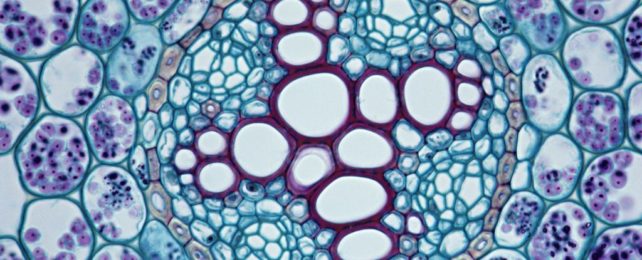A team of scientists, led by researchers at Yale University, think they have finally figured out why land plants evolved such complex vascular systems – a mystery that has stood for roughly a century.
When land plants first sprung into being roughly 500 million years ago, their vascular systems were extremely simple.
The insides of their roots and stems looked sort of like bundles of straws, which would pull in water and nutrients from the surrounding environment.
Around 420 million years ago, however, this straightforward system for sucking up water showed significant changes, gradually splitting up the 'straws' into more elaborate shapes, structures, and sizes.
For close to 100 years, scientists didn't know why evolution favored these more intricate interiors, but a new analysis of the fossil record suggests a more modern vascular system holds greater drought tolerance.
A lack of water, the authors conclude, might be what first shaped the insides of plants.
The first land plants on Earth were small, uncomplicated, moss-like forms. They didn't have root systems, which meant they were confined to areas with plentiful water.
The very first vascular plants were just centimetres tall and limited to the wettest environments.
— Martin Bouda (@BoudaLab) November 10, 2022
One of the problems they had to solve to break out of this niche was how to keep water transport through their xylem from being blocked by embolism during drought.
3/10 pic.twitter.com/rpEdoYp3vn
As plants began to move further inland into more arid areas, they needed new ways to capture water, sunlight, and nutrients while protecting themselves from evaporation and dehydration.
That's where branches and roots came in handy. And yet, at the same time, these structures also created new challenges.
During drought, plants can easily dry out, creating a bubble of vapor, sort of like an embolism, that blocks water from flowing up through the roots.
In a simple and primitive vascular system, an air bubble inside a plant can readily spread to other channels or 'straws', creating a blockade against further water and nutrients. The result can trigger tissue death, and it might even kill the entire plant.
Modeling the various vascular systems of some modern and extinct plants preserved in the fossil record, researchers have now shown that a more elaborate vascular pattern can cordon off air bubbles.
When the straws that make up a plant's vascular system are separated into patterns, simulations suggest air bubbles have fewer neighbors to spread to.
The animation below illustrates the difference between an embolism spreading in the vasculature of a simple, primitive plant versus a more complex, modern one.

The findings have researchers concluding that drought is a "theoretically sound" selection pressure for the vascular system of plants.
"Every time a plant deviates from that cylindrical vascular system, every time it changes just a little bit, the plant gets a reward in terms of its ability to survive drought," explains plant physiologist Craig Brodersen from the Yale School of the Environment.
"And if that reward is constantly there, then it's going to force plants in the direction away from the ancient cylindrical vascular system toward these more complex forms.
"By making these very small changes, plants solved this problem that they had to figure out very early in the history of the earth, otherwise the forests that we see today just wouldn't exist."
Not only do the findings reveal interesting aspects of Earth's past, but they also help explain how the vast array of vascular forms seen in modern plants today came to be and speak to future solutions.

This new understanding of how plants cope with drought could one day help researchers prepare important flora for the rapid climate changes that lie ahead.
If experts can figure out how to breed better root and vascular systems, some crops might be able to feed us long into the future.
The study was published in Science.
